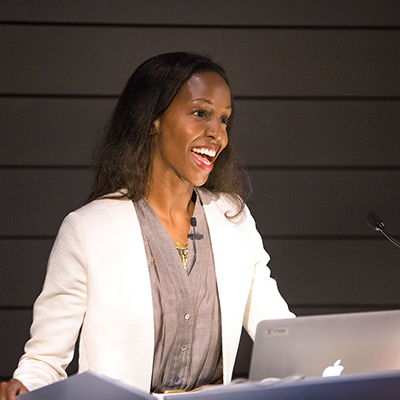Since arriving in early July, Martha Tedeschi, the new Elizabeth and John Moors Cabot Director of the Harvard Art Museums, has been doing a lot of listening. She’s met with individuals across the university, the museums, and the broader community, “learning about the important work already under way and thinking...about how we can build on our success,” as she wrote in her first Director’s Message.
That trend continued one bright and sunny day in mid-September, when Tedeschi welcomed more than 100 longtime friends and supporters of the museums to Cambridge for a daylong program aimed at showcasing the museums in motion. “Looking Forward: Thought Leadership at the Harvard Art Museums” gave these special guests the opportunity to better know the museums and the staff, students, and professors who enliven the institution. Throughout the day, Tedeschi also solicited thoughts and ideas from participants during informal small-group conversations and a series of workshops focusing on the museums’ collections and programming.
The event came at an auspicious time, as the museums have been in operation for two years following the reopening. The museums have hit their stride, Tedeschi said, and “we are doing exactly what we were meant to be doing.” That includes collaborating with a dynamic university constituency and a rich Boston arts community; offering new and better ways to encourage the close study of original works of art; and undertaking efforts to deepen and broaden the collections.
“The Room Where It Happens”
Visitors—particularly Harvard’s uniquely diverse student body—are a focus for Tedeschi, and as such were a prime topic in the day’s opening discussion: a conversation between Tedeschi and Robin Kelsey, Harvard’s newly named dean of arts and humanities. The conversation was moderated by Jessica Levin Martinez, director of the museums’ Division of Academic and Public Programs.
Tedeschi noted that the varied backgrounds and interests of Harvard students mean that curators cannot “rely exclusively on the tried and true information that we have been trained to provide,” she said, referencing the basic facts about an artist and the work that appear in a traditional gallery label. Instead, we need to think about works of art as portals, about how physical objects can open up our thinking about the world and encourage multiple perspectives.
Kelsey added that today’s Harvard students demand more, seeking a more holistic and inclusive education. “Students want engagement and to be part of a broader conversation,” he said. That sort of approach represents a chance to “educate all of us, young and old.” Quoting the popular musical Hamilton, Kelsey said he wants the museums to be “‘the room where it happens.’ I want this to be the crossroads, the conversation place.”
Exciting Acquisitions
Bringing new works into the collections is just one way to ensure that the museums spark fresh conversation and inquiry. One recent acquisition—the complete Schneider/Erdman Printer’s Proof Collection—adds 459 photographs, as well as related archival materials, to the museums’ holdings in contemporary photography. Though the bulk of the collection was acquired in 2012, Tedeschi officially announced that a final group of 66 images, including works by photographers such as Richard Avedon, David Wojnarowicz, and Peter Hujar, has just been added to the collection.
Later in the day, artist Gary Schneider and Jennifer Quick, the John R. and Barbara Robinson Family Associate Research Curator in Photography, led a workshop session highlighting the printer’s proof collection and introducing attendees to the upcoming 2018 exhibition Analog Culture: Printer’s Proofs from the Schneider/Erdman Photography Lab, 1979–2001. Quick said that the exhibition is largely designed to provide an introduction to the world of the darkroom, particularly for students who have been exposed only to digital photography. “Besides giving visitors a chance to experience what was happening in photography in the 1980s and ’90s, the exhibition will teach about what it meant to develop photos,” she said.
Announcements and Opportunities
And even more learning opportunities are on the horizon, Tedeschi reported, sharing the news that the National Endowment for the Humanities (NEH) recently awarded the museums a grant to support the Fall 2018 special exhibition Animal-Shaped Vessels from the Ancient World: Feasting with Gods, Heroes, and Kings. In addition, a new grant from the Mellon Foundation will allow for the creation of a summer institute for advanced graduate students to deepen their technical understanding of works of art, through object-based training.
These initiatives, combined with the museums’ ongoing and historic work of training museum professionals, “will enable us to broaden the impact of our teaching and scholarship,” Tedeschi said.
Indeed, so many of the conversations during the day centered on the question of how we can build upon our accomplishments and extend our pursuit of excellence. As Tedeschi settles into her new role—and continues listening, learning, and engaging with the museums’ many important constituencies—this question will be a steady guide for her leadership.

